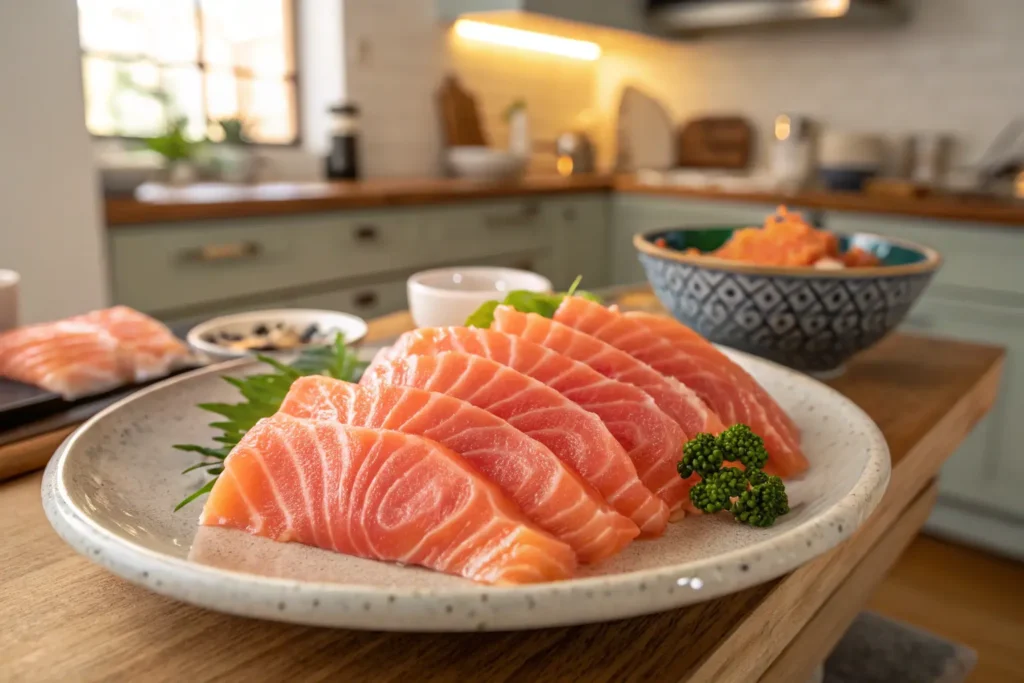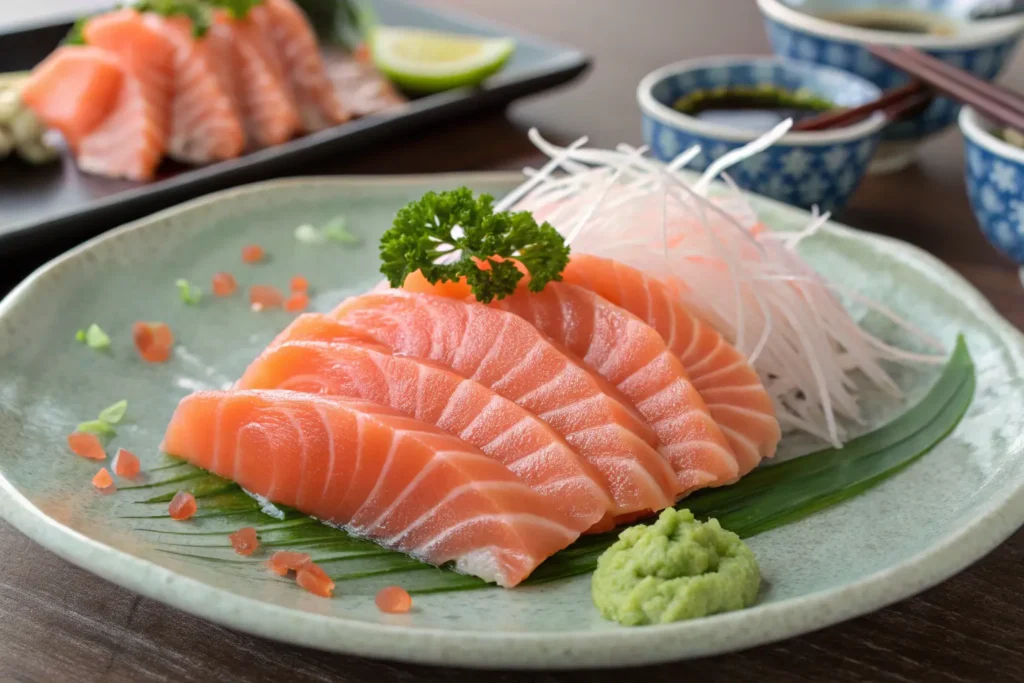The first time I sliced into a perfectly chilled piece of sushi-grade salmon in my own kitchen, I felt a mixture of excitement and trepidation. Could I really create restaurant-quality salmon sashimi at home? That first bite—silky, buttery, with that subtle ocean freshness—answered with a resounding yes. Today, I want to share that same transformative experience with you. Whether you’re looking to impress dinner guests or simply treat yourself to a luxurious culinary adventure without the restaurant price tag, mastering salmon sashimi at home is a skill that will forever change your relationship with seafood.
Preparing salmon sashimi in your own kitchen grants you complete control over quality, freshness, and presentation. You’ll discover the subtle differences between salmon varieties, perfect your knife skills, and create a dish that rivals your favorite Japanese restaurant—all while spending a fraction of what you’d pay dining out.
Table of contents

Understanding Salmon Sashimi: The Essentials
What Makes Salmon Perfect for Sashimi
Salmon stands as the undisputed champion of home sashimi preparation for good reason. Its naturally high fat content creates that melt-in-your-mouth texture that distinguishes exceptional sashimi. Unlike leaner fish that might become tough or stringy when served raw, properly prepared salmon delivers unparalleled silkiness.
Different salmon varieties offer distinctive experiences. King (Chinook) salmon boasts the highest fat content, providing rich, buttery slices ideal for sashimi newcomers. Sockeye delivers a more pronounced flavor with its deep red flesh, while Atlantic salmon offers consistent quality and availability year-round. When selecting your fish, consider that deeper orange-red hues typically indicate higher fat content and more robust flavor profiles.
Sushi-Grade vs. Regular Salmon: Critical Differences
Never substitute regular supermarket salmon for sashimi preparation. The term “sushi-grade” isn’t merely marketing—it indicates fish that has undergone specific handling protocols to ensure safety for raw consumption. Properly designated sashimi salmon has been frozen at temperatures low enough (-4°F/-20°C or below) to eliminate potential parasites.
When shopping, look for clear labeling indicating “sushi-grade” or “for raw consumption.” Reputable fishmongers will readily verify their salmon meets these standards. The fish should exhibit clear eyes, bright red gills, and flesh that springs back when gently pressed. Most importantly, it should smell fresh and oceanic—never fishy or ammonia-like.
Essential Tools for Perfect Salmon Sashimi
The Right Knife Makes All the Difference
While specialized Japanese yanagiba knives represent the gold standard for sashimi preparation, you needn’t invest hundreds in professional cutlery to achieve excellent results. The essential qualities in any sashimi knife include exceptional sharpness, appropriate length (at least 8 inches), and a thin, precise blade.
Many home cooks successfully utilize high-quality chef’s knives or slicing knives with proper technique. The crucial factor remains maintaining impeccable sharpness—a dull knife crushes and tears delicate fish flesh rather than creating clean, precise slices. Consider investing in a quality whetstone and learning basic sharpening techniques if you’ll prepare sashimi regularly.
Beyond the Knife: Essential Equipment
Must-Have Tools
Beyond your knife, several essential tools facilitate sashimi preparation. A dedicated cutting board—preferably wood or high-density plastic—provides an appropriate surface that won’t dull your blade. Keep this board exclusively for raw fish preparation to prevent cross-contamination. Cold storage containers with tight-fitting lids maintain freshness during preparation, while kitchen towels dampened with cold water help maintain ideal temperature throughout the cutting process.
Nice-to-Have Accessories
Traditional accessories enhance both preparation and presentation. A traditional bamboo or cypress wood serving platform (called a geta) elevates your presentation literally and figuratively. Specialized fish tweezers make removing pin bones effortless, while a genuine wasabi grater transforms fresh wasabi root into the authentic condiment that bears little resemblance to the common paste substitute.
Sourcing Sushi-Grade Salmon Safely
Finding Reputable Suppliers
Your sashimi journey begins with finding trustworthy suppliers. While specialty fish markets offer the most reliable sources, many metropolitan areas now boast Japanese grocery stores with dedicated sushi counters. Even some upscale supermarkets maintain relationships with sushi-grade suppliers.
For those without local access, numerous online retailers specialize in overnight shipping of flash-frozen sashimi-grade fish. Reputable services like Catalina Offshore Products, The Lobster Place, and Fulton Fish Market maintain rigorous safety standards and transparent sourcing practices.
When approaching your fishmonger, ask direct questions: “Was this fish previously frozen at temperatures low enough to kill parasites?” “How long has it been since harvesting?” “How should I store this at home?” Quality suppliers welcome these inquiries and provide confident, detailed responses.
What to Look for When Buying Salmon for Sashimi
Train your senses to recognize quality salmon. Visually, seek consistent coloration without brown spots or discoloration. The flesh should appear moist and translucent, never dry or opaque. When touching (with permission), the flesh should feel firm and resilient—never mushy or grainy.
Trust your nose as your most reliable tool. Fresh salmon carries a mild, clean scent reminiscent of ocean breezes. Any strong “fishy” odor indicates deterioration and makes the fish unsuitable for raw consumption. Proper packaging should maintain consistent cold temperatures without excess liquid accumulation.

Sustainable Choices for Environmentally Conscious Cooks
Modern sashimi enjoyment comes with responsibility toward ocean ecosystems. Wild Alaskan salmon represents one of the most sustainable choices, managed under strict fishery regulations that prevent overharvesting. Look for Marine Stewardship Council (MSC) certification indicating sustainable harvesting practices.
Farm-raised salmon offers another option, though environmental impact varies dramatically between operations. Closed-system farms and those with Aquaculture Stewardship Council (ASC) certification typically implement more responsible practices. Consider seasonal availability as well—purchasing during peak harvest seasons ensures fresher fish with smaller carbon footprints from transportation.
Preparing Your Kitchen for Salmon Sashimi Success
Creating a Clean Workspace
Sashimi preparation demands hospital-grade cleanliness. Before beginning, sanitize all surfaces with food-safe disinfectant. Wash hands thoroughly with antibacterial soap before handling fish, and keep separate towels for hand-drying and equipment-drying to prevent cross-contamination.
Maintain temperature control throughout preparation. Pre-chill serving dishes in the refrigerator, and consider placing your cutting board on a larger baking sheet filled with ice to maintain optimal temperature during cutting. This extra precaution preserves both safety and texture.
Mise en Place: Setting Yourself Up for Success
Professional chefs swear by mise en place—having everything in its place before beginning. Prepare all accompaniments before retrieving your salmon from refrigeration. Slice garnishes, portion condiments, and arrange serving vessels beforehand. This organization minimizes the time your valuable fish spends at room temperature.
Plan your workflow sequentially: initial inspection, portioning, skin removal, precise cutting, and immediate plating. Having a clear mental roadmap ensures efficiency and allows you to focus entirely on technique during the crucial cutting phase.
Step-by-Step Guide to Preparing Salmon Sashimi
Preparing the Salmon
Begin by inspecting your salmon carefully under bright light. Remove any remaining pin bones using fish tweezers or needle-nose pliers, pulling in the direction of the bone rather than straight up to prevent tearing the flesh.
When removing the skin, position your knife at the junction between skin and flesh at a 45-degree angle. While firmly gripping the skin with a kitchen towel, draw the knife toward you in a smooth, controlled motion, allowing the weight of the blade to separate skin from flesh. Take your time with this step—rushing often results in wasted fish or uneven cuts.
Master Cutting Techniques for Perfect Slices
Proper cutting technique distinguishes amateur efforts from restaurant-quality results. Position your knife at a 45-degree angle to the fish, with the blade facing away from you. Rather than sawing, execute a single, confident pulling motion, drawing the knife through the fish in one smooth stroke. This technique creates the clean edge essential for optimal texture and presentation.
Traditional sashimi thickness ranges from 1/4 to 1/8 inch (6mm to 3mm), though personal preference may dictate slight variations. Consistency matters more than absolute thickness—each slice should mirror its neighbors precisely. Between cuts, wipe your blade clean with a dampened towel to maintain pristine edges on subsequent slices.
Traditional Garnishes and Accompaniments
Essential Accompaniments Table
| Ingredient | Traditional Use | Preparation Method | Flavor Profile |
|---|---|---|---|
| Wasabi | Antibacterial properties, flavor enhancer | Fresh grated or reconstituted powder | Sharp, pungent heat |
| Soy Sauce | Dipping sauce | Select low-sodium varieties for best flavor | Umami, salty |
| Pickled Ginger | Palate cleanser | Thinly sliced and pickled | Sweet, tangy, refreshing |
| Shiso Leaves | Garnish, flavor enhancer | Whole or julienned | Minty, basil-like |
| Daikon Radish | Base, garnish | Finely grated or thinly sliced | Mild peppery freshness |
The traditional approach places a small amount of wasabi directly on the fish rather than dissolved in soy sauce. This allows you to control the precise amount of heat while experiencing the complex flavors that commercial wasabi pastes often lack. True wasabi loses potency within 15 minutes of grating, so prepare just before serving for maximum impact.
Presentation Techniques That Elevate Your Salmon Sashimi
Traditional vs. Modern Plating Styles
Japanese culinary tradition emphasizes minimalist presentation that showcases the natural beauty of ingredients. Traditional sashimi plating arranges slices in a slightly overlapping pattern resembling fallen dominoes, often curved or arranged in a circular pattern. Modern approaches might incorporate more dramatic plating techniques, including vertical elements or asymmetrical arrangements.
Regardless of style, temperature remains paramount. Chill plates thoroughly before serving—ideally 15 minutes in the refrigerator before plating. This simple step prevents your carefully prepared salmon from warming too quickly and maintains that signature cold, firm texture throughout the dining experience.
Garnishing for Visual Impact
Strategic garnishing transforms good sashimi into memorable culinary art. Consider the color wheel when selecting accents—the vibrant orange-pink of salmon pairs beautifully with complementary colors like green (microgreens, shiso leaves) and purple (edible flowers, perilla).
Texture contrasts equally enhance presentation. Crisp vegetable garnishes like daikon spirals or cucumber flowers provide textural counterpoints to the soft fish. Practice simple garnishing techniques like vegetable carving or herb chiffonade to add professional flourishes without overwhelming the star ingredient.

Frequently Asked Questions About Salmon Sashimi
Safety and Selection FAQs
Q: How do I know if salmon is safe for sashimi preparation at home? A: Salmon suitable for sashimi should be clearly labeled as “sushi-grade” or “sashimi-grade” and purchased from reputable suppliers who freeze their fish to specific temperatures to kill potential parasites. The salmon should smell fresh and oceanic, not fishy, and have firm, translucent flesh.
Q: Can I freeze regular salmon to make it safe for salmon sashimi? A: Home freezers typically don’t reach the required temperatures (-4°F/-20°C for 7 days) to guarantee parasite elimination. For safe salmon sashimi, always purchase properly handled sushi-grade fish that has undergone commercial flash-freezing.
Q: How long can I store sushi-grade salmon before making sashimi? A: Even sushi-grade salmon should be prepared within 24-48 hours of purchase for optimal salmon sashimi quality. Keep it in the coldest part of your refrigerator (usually the bottom shelf at the back) until ready to use.
Preparation and Technique FAQs
Q: What’s the ideal thickness for salmon sashimi slices? A: Traditional salmon sashimi slices are approximately 1/4 inch (6mm) thick, though this can vary slightly based on personal preference and the fat content of your particular salmon.
Q: Do I need a special knife to make proper salmon sashimi at home? A: While a traditional Japanese yanagiba knife is ideal for salmon sashimi preparation, any extremely sharp, long, thin-bladed knife will work. The key is maintaining an exceptionally sharp edge for clean cuts that don’t damage the delicate fish texture.
Your Journey to Salmon Sashimi Mastery
With these techniques mastered, you’ve joined a centuries-old tradition of culinary artistry. The skills you’ve developed preparing salmon sashimi at home extend beyond this single dish—precision knife work, understanding quality ingredients, and presenting food beautifully are foundations of all great cooking. Each time you prepare this elegant dish, you’ll find new nuances to perfect and enjoy.
Remember that mastery comes with practice, so don’t become discouraged if your first few attempts fall short of restaurant-perfect. The journey of perfecting your homemade salmon sashimi delivers rewards far beyond the destination—though that destination certainly tastes exceptional.
Have you crafted your own salmon sashimi masterpiece? Share your photos and experiences in the comments below! Which techniques made the biggest difference in your preparation? Did you discover any personal touches that enhanced your sashimi experience? Your fellow culinary explorers eagerly await your insights and inspiration!
Have you given our recipe a try?
There are no reviews yet. Be the first one to write one.

